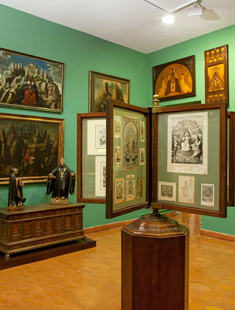Montserrat Hall (Hall 3)

We now begin our tour of the hall dedicated to the mountain of Montserrat and to the Benedictine monastery and the Virgin Mary of the same name.
The mountain is located about 20 kilometers to the northeast of Barcelona and is one of the most unique in Catalonia. Its jagged profile led to its name-in Catalan, mont means mountain and serrat means saw.
The Virgin of Montserrat is known as "la Moreneta", a name that makes reference to her dark skin. Her feast day is celebrated on April 27th and she has been the patron saint of Catalonia since the late 19th century. Her cult has spread throughout Spain, all of Europe and the Americas.
The legend says that at the end of the 9th century, a group of shepherds saw a ray of light shining down from the sky; accompanied by heavenly canticles, it settled on the mountain top. This vision repeated itself on four separate occasions. When the bishop was informed, he organized an expedition and a cave was discovered. Inside was a statue of the Virgin Mother. The prelate ordered it to be moved, but it was so heavy that it could not be lifted. It was deduced that the Virgin wanted to remain there, and the construction of a chapel was begun in that very spot.
This room features a collection of more than 600 pieces related to Montserrat, including paintings, sculptures and engravings. There are also reliquaries, medals, prints and more.
The statue that is currently worshipped in the monastery is Romanesque. The mother holds the Christ child on her lap, acting as a throne. Throughout the centuries, the figure has undergone many changes of robes and accessories, resulting in the alteration of her appearance, that we can appreciate as we look at the various pieces and objects in this gallery.
During the Baroque era, a first order iconographic model was established. The Virgin Mary is shown as a queen and lady, dressed in a loose tunic and rich gems, with the child on her lap and the imposing mountain at her back.
A good example of the success enjoyed by this model is found in the large oil located between the windows. The piece is derivative of the interpretation proposed by Italian artist Juan Andrés Ricci.
In the mid 19th century, following the Peninsular War (1808-1814), we see the first representations of the Virgin in a static, bell-shaped tunic-a style that would last until the Spanish Civil War (1936-1939). Just opposite, notice the marquetry panels by the great Modernist decorator Gaspar Homar. After 1939, the vera effigy of this statue was sought, eliminating all artifice that had hidden its original look over the centuries and making all possible efforts to return the piece to its authentic state.


